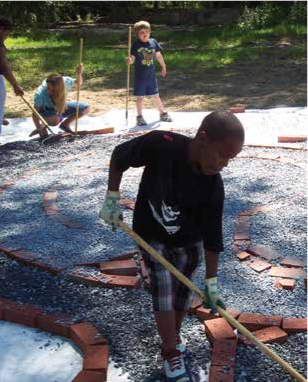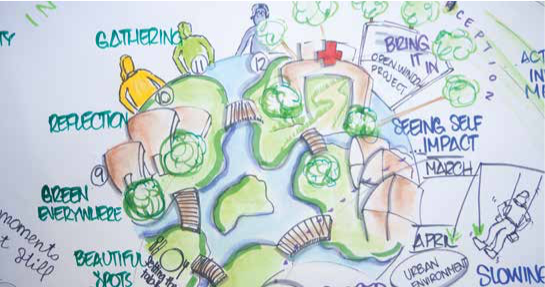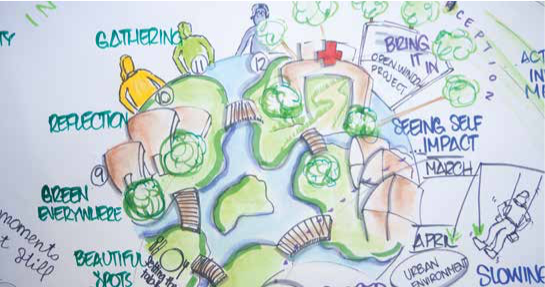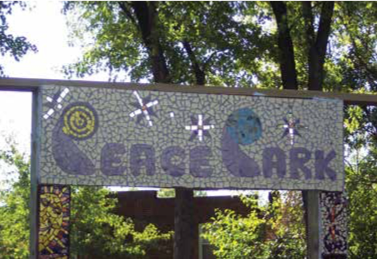In our Open Voices blog we share insight from leaders in our communities who are advancing what it means to have sacred, open green spaces in our cities. This month we examine the need for equal access to healthy urban spaces.
At times, a community recognizes the absence of nature, and works for change. At the other end of the scale a broader planning program for green spaces and sustainability provides a framework for future action. Jill Wrigley and Timothy Beatley exemplify leaders working at the local and global level to bring green spaces into our communities:
Case Study: Irvington Peace Park in Baltimore, Maryland

In some places new parks are built from within. Irvington is a neighborhood of 5,600 residents in southwest Baltimore, about one square mile in area. Irvington experiences above average crime and violence, low education levels, and 22% of households are below the national poverty level. Nearly 90% of residents are African American.
A city study in 2009 described how inequitable spatial distribution of parks in relation to race and ethnicity was an expression of urban environmental inequality.1 Irvington residents had no place to relax in nature and no shared public place.
Change can come as a city partners with grassroots organizations and supports the hard work of community members. Led by a local resident and urban farm researcher, Jill Wrigley, a community association worked with the city to condemn an abandoned lot, remove a derelict house, and clean up junk and weeds. The ongoing project, originally funded by the TKF Foundation, has become the Irvington Peace Park.
After gaining access for public use, the space was deeded to a nearby church. In 2004 design plans began to form with input from neighborhood children and the help of a landscape designer. The green space now has fruit trees, a TKF bench, tree stump stools, raised beds, a wooden platform for art performance, peace flags, and a native plant garden.
This and similar projects often struggle to achieve planning that can foster inclusion in a healthy way for all. The site originally included a labyrinth but the stones used to line the walkway were removed because community members were reconfiguring them into gang signs or potentially dangerous play structures. Other challenges of a community may be reflected in parks design; the Irvington site includes a memorial flowerbed dedicated to friends and family members lost to neighborhood violence.
As Jill Wrigley commented, “An urge for peace and beauty is something all souls need”. Activities in the park are dedicated to peace. In the summer
of 2013, during a mini-art camp, children went out of the park to ask friends and family members about their hopes for themselves, their families, their community, and the world. The children then wrote these prayers and wishes onto ribbons and tied them to branches on a tree. In the spring of 2014 community members gathered to plant in the memorial garden, have family photos taken outside, interact with wildlife with a visiting falconer, and make more prayer ribbons to adorn the park trees. Community members are in the process of expanding plans for the park site and other nearby lands, integrating space for respite and healing, growing food, supporting biodiversity, and providing job skill development for local young people.
Case Study: Biophilic Cities
In other places environmental equality is imbedded within broader planning initiatives. The Biophilic City concept puts nature first in design, planning and management. It supports equitable human contact with nature, and integrates the environmental services and economic values provided by nature and natural systems. Such cities are full of all types of nature, large and small, planned or conserved; all residents have opportunities to feel, see and experience nearby nature.
Biophilia is a theory about how humans are hard-wired to respond to nature. As the human species evolved people were dependent on nature for life itself – food, water, shelter, and other needs. We evolved in response to and in cooperation with the natural world and its processes, as opposed to the increasingly mechanized world we inhabit. This idea may explain the surge of recent studies that indicate people need frequent contact with nature and other forms of life to be well and healthy.
Nature is central to the everyday life and assumptions of a biophilic city’s governance, leadership, and populace. Timothy Beatley, author and director of the global Biophilic City Network, states, “A biophilic city is not just about its physical conditions or natural setting, and it is not just about green design and ecological interventions – it is just as much about a city’s underlying biophilic spirit and sensibilities, about its funding priorities, and about the importance placed on support for programs that entice urbanites to learn more about the nature around them…” 2.

Biophilic city planners incorporate nature into the design of every new project, and work to restore or repair what is considered native or sustainable. Now in development are indicators and metrics that can be used to measure or promote specific planning and design practices. The indicators include infrastructure, resident behaviors and lifestyles, building practices and patterns, and the dynamics of governance, including attitudes, knowledge, and institutions.
1
Boone, C.G., G.L. Buckley, J.M. Grove, and C. Sister. 2009. Parks and people: An environmental justice inquiry in Baltimore, Maryland. Annals of the Association of American Geographers 99: 767-787.
2
Beatley, T. 2011. Biophilic Cities: Integrating Nature in Urban Design and Planning. Island Press: Washington DC.


